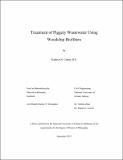| dc.description.abstract | Pig production is the third most important sector in Irish agriculture and it is a
highly intensive industry with over 70% of commercial sows in herds of 500 or
greater in 2011. It is estimated that 3.1 million tonnes of pig manure are produced
in Ireland annually. The current practice for pig manure disposal is landspreading,
which generates handling and transportation costs for pig farmers, and poses
threats to the environment through the release of nutrients into water bodies and
the emissions of greenhouse gases. Treatment of pig manure offers an alternative
to landspreading. The aim of the study was to investigate the treatment of the
piggery wastewater - the separated liquid fractions of raw pig manure (SR) and
pig manure following anaerobic digestion (SAD) - using a woodchip biofilter
technology, which has been developed in NUI Galway. The study was carried out in six sections: a literature review; a laboratory-scale study in NUI Galway; a pilot-scale study in Teagasc Moorepark Research Centre; further treatment of biofilter effluent by chemical treatment; the analysis of greenhouse gas emission from pilot-scale biofilters; and a cost analysis of the woodchip biofilter treatment technology. In the laboratory-scale study 12 aerobic woodchip biofilters of 0.6 m depth were constructed to treat SR and SAD at two hydraulic loading rates; 5 L/m2.day (LLR) and 10 L/m2.day (HLR). Results of the laboratory-scale study indicate that 0.6 m deep SR woodchip biofilters were successful in removing 62% suspended solids (SS), 64% total COD (CODt), 30% total nitrogen (TN) and 60% ammonium-nitrogen (NH4+-N) at LLR and 45% SS, 47% CODt, 31% TN and 44% NH4+-N at HLR. Greater removals of CODt, filtered COD (CODf), TN, filtered total nitrogen (TNf) and NH4+-N were achieved at LLR than at HLR for the SAD woodchip biofilters. Woodchips immersed in SAD biofilter effluent containing high concentrations of oxidised nitrogen significantly reduced NO2--N and NO3--N in the liquid. This indicates that saturated woodchips provided carbon and anoxic conditions to encourage removal of oxidised nitrogen through denitrification. Six pilot-scale biofilters consisting of 1 m aerobic woodchip layers and 0.5 m saturated woodchip layers were constructed to treat the SR and SAD. The SR pilot-scale woodchip biofilters were successful in removing 49% dry matter (DM), 71% CODt, 87% 5-day biochemical oxygen demand (BOD5), 89% TN and 91% total phosphorous (TP). Reductions of 54% DM, 80% CODt, 93% BOD5, 86% TN and 79% TP were achieved in the SAD pilot scale woodchip biofilters. The study results confirm the occurrence of nitrification in the aerobic woodchip layers and denitrification in the submerged layers. The pilot-scale biofilter effluent was polished with chemical treatment. Chemical polishing with aluminium sulphate was found to be better than lime. Chemical treatment with aluminium sulphate removed 71% turbidity, 63% CODt and 50% TP from the SR woodchip biofilter effluent, and removed 84% turbidity, 76% CODt and 99.6% TP from the SAD biofilter effluent. The measurement of greenhouse gas (CH4, N2O and CO2) emissions from the pilot-scale woodchip biofilters using a chamber based flux measurement indicated that the average GHG equivalent emissions from the woodchip biofilters were 264 kg CO2e/ha/day and 217 kg CO2e/ha/day from the SR and SAD woodchip biofilters, respectively. The cost analysis indicates that the woodchip biofilter technology is not cost effective when compared to the cost of landspreading. It may become cost effective in the future due to further restrictions to landspreading and imminent rising fuel prices. The woodchip biofilter technology has been shown to be a simple and efficient treatment technology with low maintenance. It can be easily adapted by the Irish pig industry and offer an environmentally beneficial alternative to landspreading. | en_US |


